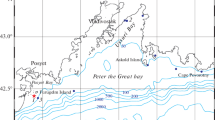Abstract
It is shown that the process of eddy formation behind a coastal cape essentially depends on the method by which longshore flow is generated. Numerical simulations of the flow around a cape generated by transient longshore wind have revealed different modes of eddy formation in a rotating stratified environment depending on such dimensionless parameters as the Burger and Kibel–Rossby numbers, Bu and Ro, respectively. At Ro < 0.6, depending on the magnitude of Bu, either a trapped anticyclonic or cyclonic eddy (at Bu < 0.2) or periodic eddy shedding (at Bu < 0.2) forms. The eddies are weakened and stretched along the coastline at 0.4–0.6 < Ro < 1.4 and ultimately disappear at Ro < 1.4.
Similar content being viewed by others
References
D. N. Elkin and A. G. Zatsepin, “Laboratory investigation of the mechanism of the periodic eddy formation behind capes in a coastal sea,” Oceanology (Engl. Transl.) 53, 24–35 (2013).
A. F. Blumberg and G. L. Mellor, “Diagnostic and prognostic numerical calculation studies of the South Atlantic Bight,” J. Geophys. Res.: Oceans 88 (8), 4579–4592 (1983).
D. Boyer and L. Tao, “On the motion of linearly stratified rotating fluids past capes,” J. Fluid Mech. 180, 429–449 (1987).
P. A. Davies, P. Besley, and D. L. Boyer, “An experimental study of flow past a triangular cape in a linearly stratified fluid,” Dyn. Atmos. Oceans 14 (6), 497–528 (1990).
C. Dong, J. C. McWilliams, and A. F. Shchepetkin, “Island wakes in deep water,” J. Phys. Oceanogr. 37 (4), 962–981 (2007).
E. T. Eady, “Long waves and cyclone waves,” Tellus 1 (3), 33–52 (1949).
P. K. Kundu and I. M. Cohen, Fluid Mechanics (Academic, New York, 2002).
M. G. Magaldi, T. M. Özgökmen, A. Griffa, et al., “Turbulent flow regimes behind a coastal cape in a stratified and rotating environment,” Ocean Model. 25, 65–82 (2008).
R. D. Pingree and L. Maddock, “The effects of bottom friction and Earth’s rotation on an island’s wake,” J. Mar. Biol. Ass. U.K. 60 (2), 499–508 (1980).
E. Wolanski, J. Imberger, and M. Heron, “Island wakes in shallow coastal waters,” J. Geophys. Res.: Oceans 89 (6), 10553–10569 (1984).
V. Zhurbas, I. S. Oh, and T. Park, “Formation and decay of a longshore baroclinic jet associated with transient coastal upwelling and down welling: a numerical study with applications to the Baltic Sea,” J. Geophys. Res.: Oceans 111 (4), C04014 (2006). doi 10.1029/ 2005JC003079
Author information
Authors and Affiliations
Corresponding author
Additional information
Original Russian Text © V.M. Zhurbas, N.P. Kuzmina, D.A. Lyzhkov, 2017, published in Okeanologiya, 2017, Vol. 57, No. 3, pp. 389–399.
Rights and permissions
About this article
Cite this article
Zhurbas, V.M., Kuzmina, N.P. & Lyzhkov, D.A. Eddy formation behind a coastal cape in a flow generated by transient longshore wind (Numerical experiments). Oceanology 57, 350–359 (2017). https://doi.org/10.1134/S0001437017020229
Received:
Accepted:
Published:
Issue Date:
DOI: https://doi.org/10.1134/S0001437017020229




